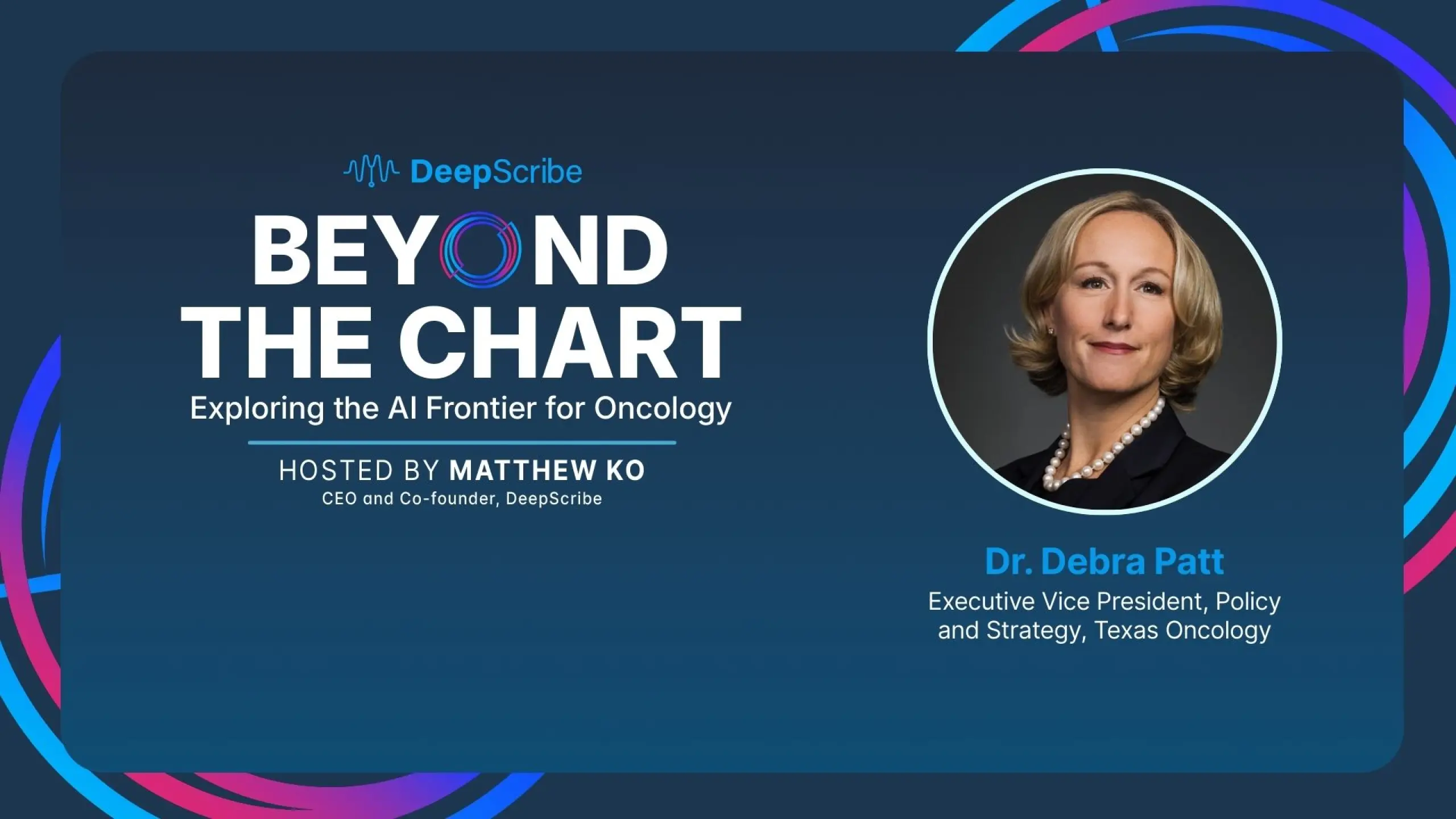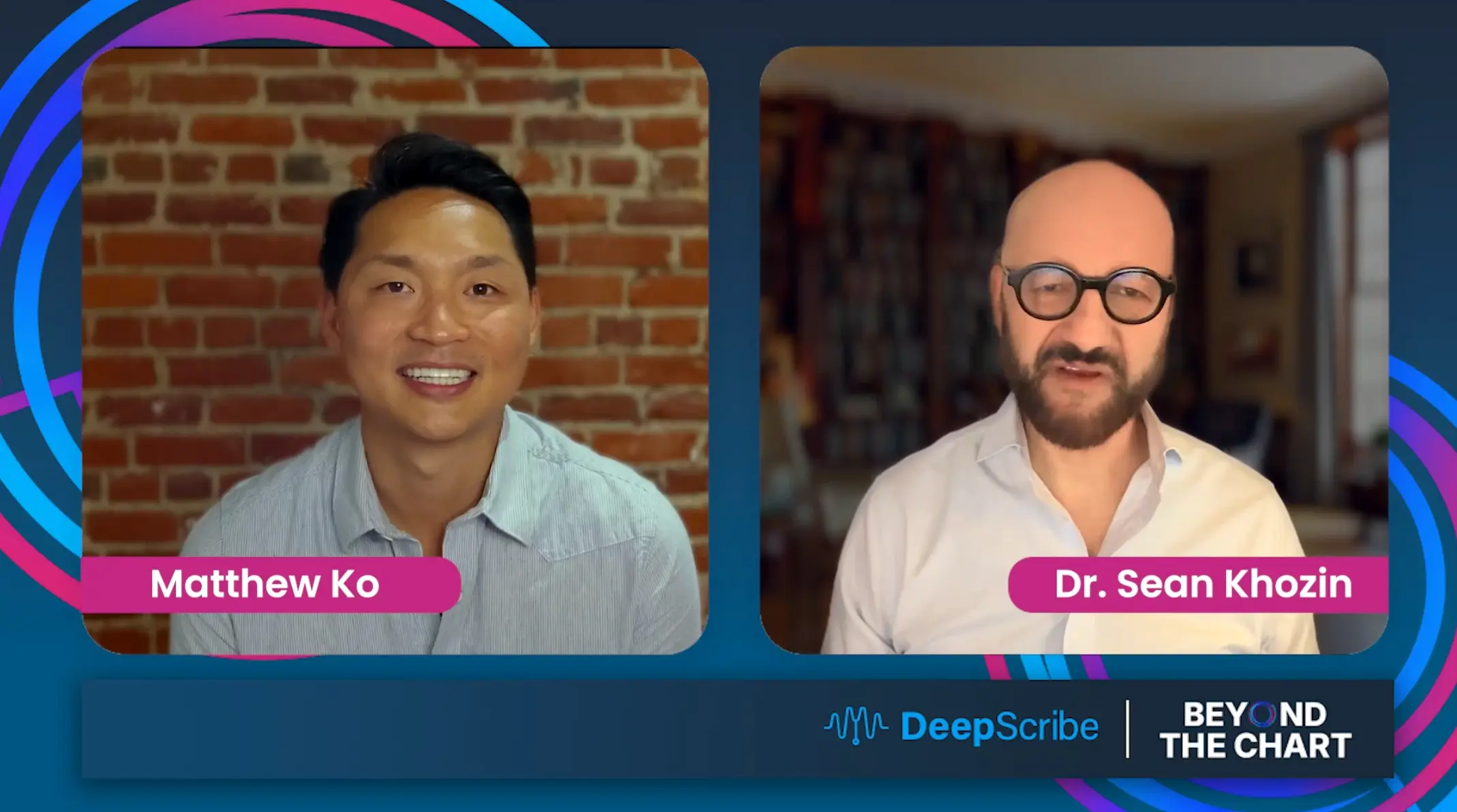Paving the Road to Nirvana in Oncology: A Conversation with Dr. Debra Patt
An oncologist, policy leader, and informatics expert, Dr. Patt explores the elements of cancer care “nirvana” with DeepScribe founder and CEO Matthew Ko. It’s an unfiltered look at a future view of oncology and the role AI will play.


Summary
Guest:
Dr. Debra Patt, MD, PhD, MBA; Executive Vice President of Policy and Strategy, Texas Oncology
Insights:
- Nirvana in cancer care is a future state where clinicians act at the top of their license, patients don’t wait, and the care journey fits into a patient’s life instead of disrupting it.
- Physicians have the “Ferraris of healthcare innovation.”. But Ferraris need highways—the infrastructure, workflow, and digital tools that let care delivery actually improve.
- Technology companies must come see physicians in clinic to understand their workflow and patients. There’s a big communication gap and meaningful innovation depends on closing it.
For years, the oncology community has been reshaping cancer care delivery—expanding access, modernizing workflows, and weaving digital tools into the fabric of practice. As this piece-by-piece evolution continues, one fundamental question remains: What can the future of cancer care truly look like?
Dr. Debra Patt is a clinical leader who insists on both asking the question and forming its answer. She is a breast oncologist and Executive Vice President at Texas Oncology, president of the Community Oncology Alliance, and chair of ASCO’s AI Task Force.
In an episode of Beyond the Chart: Exploring the AI Frontier in Oncology, Dr. Patt talks with show host Matthew Ko, DeepScribe founder and CEO, about her framework for reaching “nirvana” in oncology, the role of ambient AI in oncology, and the work required to achieve an ideal state of cancer care delivery.
As Matt points out, few leaders sit at the intersection of clinical practice, policy, technology, and operations as Dr. Patt does. Throughout their discussion, a central theme emerges that surfaces often on the show: innovation matters most when it restores presence with patients and strengthens the human connection in oncology.

The Human Foundations of Great Cancer Care
For Dr. Patt, the science of breast oncology is the relatively easy part. The harder, more meaningful work is helping patients navigate the emotional and practical complexities of their cancer diagnosis.
“I want my interaction with patients to make them feel better… I don’t want them to see the back of my head because I’m typing. I want to be present with them. Touch them when they cry, hand them a tissue, walk them through education.”
Dr. Patt’s philosophy has guided her across twenty years of practice: Treating cancer is more than applying evidence-based therapies; it’s ensuring that treatment doesn’t consume a patient’s life. Presence, education, and context shape outcomes as powerfully as clinical decisions.
Her perspective reflects an emerging truth in oncology, that technologies with the greatest impact are those that protect or enhance the connection clinicians have with their patients, not divert them away from it.
Why Change in Oncology Takes Time and What Must Shift
Early in her career, Dr. Patt assumed transformation in oncology care delivery would happen quickly. Every indicator suggested rapid change.
But the reality, she notes, has been more complex.
The barrier to rapid advances is threefold: changing clinician workflow (and making it stick), aligning operations, and implementing technology at scale. These are the demands of digital transformation, and they’re inherently difficult in a field where time is limited and the stakes can be deeply personal.
Organizations succeed or stall based not on invention, but on implementation.
Dr. Patt explains that the greatest lift isn’t choosing the right tools—it’s designing a path that clinicians can follow that’s supported by champions, training, infrastructure, and partnership. The technology on its own isn’t enough to drive innovation.
The Return to Presence: Ambient AI Improving Oncology Workflows
Ambient AI has emerged as a powerful example of technology that meaningfully changes the care experience for both clinicians and patients.
At Texas Oncology, Dr. Patt helped guide one of the largest deployments of ambient AI in oncology to date. The effort succeeded because of the culture created to ensure the implementation’s success: physician champions, local influencers, thoughtful rollout strategies, and a vendor partnership (with DeepScribe) that supported rapid iteration. (As Dr. Diane Reidy-Lagunes reminded us on an earlier podcast episode, culture eats strategy for lunch.)
Clinicians reclaimed time. Patients experienced more uninterrupted attention. Just as important, the path toward advanced capabilities and opportunities emerges, with clinical intelligence, trial matching, care coordination, and more.
Dr. Patt sees clinical documentation AI as the first mile of a much longer highway. Beyond lies a continuum of functionalities driven by AI in cancer care workflows, working together to fundamentally transform how oncology is delivered.
Clinical Intelligence Use Cases in Oncology
Dr. Patt shares powerful real-world examples of how AI is already elevating clinical decision-making when uncommon questions arise.
“I usually know within 30 seconds of walking in a room what I need to do to treat someone's breast cancer. A difficult decision is with the many other things that interact with a human to make care delivery complicated.”
In one case, the results of an AI-supported literature search helped her prevent a young patient from getting an unnecessary brain biopsy. The patient mentioned a previous condition, and the clinical tool expanded the diagnostic picture.
In another, Dr. Patt used the tool to evaluate whether ketamine therapy posed any risk of cancer recurrence for a patient who was being treated for major depression. The resulting knowledge enabled treatment that would otherwise have been delayed.
These moments, she notes, aren’t about replacing clinical judgment. They’re about enhancing it:
“Large language models have already made me a better clinician… They help me answer complex questions at the point of care, quickly and accurately.”
Clinical intelligence, delivered in context and in real time, is becoming one of the most promising frontiers in oncology.
Building the Ferrari Highway for Cancer Care
During the conversation, Dr. Patt shared a metaphor that describes the gap between the creation of innovation and the realization of its impact.
“We’ve built the Ferraris of care delivery… but Ferraris need highways.”
The “Ferrari” is the technology—advanced, powerful, full of potential. The highway is everything else needed to move that Ferrari along. That includes an effective workflow, policy, data infrastructure, risk mitigation, patient education, and operational readiness.
Without the highway, the Ferrari can’t perform at its best. And without thoughtful federal policy underlying the highway, it becomes fragmented state by state.
Dr. Patt’s call to action is clear: Bring consistent policy frameworks, practical guardrails, and operational feasibility to oncology innovation. Only then can technology accelerate care instead of complicating it.
Patient Education and AI-Generated Personalization
For all the advances in cancer therapeutics, patient education remains one of the most underserved elements of oncology care. Patients receive dense printouts and overwhelming information at a moment when their capacity to absorb it is limited.
Dr. Patt sees enormous opportunity here. Texas Oncology is piloting short-form, one-minute video modules to engage and educate patients, “small bits of content in a way that people want to see it.”
Dr. Patt believes the next wave of AI-enabled innovation will further personalize this experience, tailoring education to patient preferences and real-time clinical needs.
It’s a natural extension of ambient technology, all part of an increasingly better care delivery. The patient’s full story is understood and responded to with intelligence, clarity, and humanity.
The Road to Nirvana Begins with Partnership
Dr. Patt’s vision of nirvana in oncology is compelling. It combines precise science, compassionate connection, and efficient delivery, all seamlessly integrated into patients’ lives.
“Nirvana is a place of perfect healthcare in the future where doctors and nurses act at the top of their license and patients are able to spend minimal time in their care journey so they can be focused on their lives.
Reaching this nirvana requires more than tools. It requires partnerships, shared understanding, and alignment across clinicians, technologists, and oncology organizations.
The conversation between Dr. Patt and Matt closes with a reminder that comes up frequently on Beyond the Chart: Innovation is a two-way street. Technologists must understand the day-to-day (and sometimes, hour-by-hour) reality of a clinician. Clinicians must be willing to embrace new workflows and give feedback that fuels iteration. All leaders involved must create the conditions for trust and change to take root.
text
| AI Medical Scribe | KLAS score | Specialty support | Documentation intelligence (context, coding, automation) | EHR Support | Customization | Rollout model and enterprise readiness | Best for |
|---|---|---|---|---|---|---|---|
| DeepScribe | 98.8 / 100* | Deep specialty coverage: oncology, cardiology, urology, orthopedics, gastroenterology, + more | Contextual notes (pulls history, labs,, etc.) CPT, ICD-10, HCC coding | Epic, athenahealth, DrChrono, eClinicalWorks, iKnowMed, OncoEMR, UroChart, ModMed, Objective Medical Systems, + more | Deep, per-clinician customization; learns each clinician’s style and supports granular control over templates, structure, and phrasing. | Structured enterprise rollouts with governance, analytics, and at-the-elbow support | Health systems, private practices, and specialists that need customizable, specialty-aware AI for complex workflows |
| Abridge | 95.3 / 100 | Strong in primary care and templated, compliance-driven workflows | Contextual notes (pulls history, labs,, etc.) CPT, ICD-10, HCC coding | Epic (primarily), athenahealth, Cerner | Configurable templates and note sections; orgs define templates, clinicians adjust sections within structured, guideline-aligned notes | Enterprise deployments optimized for Epic workflows | Health systems on Epic, particularly within primary care |
| Commure | 93.3 / 100* | General coverage; specialty outcomes still emerging | CPT, ICD-10 coding | Broad EHR support | Custom templates | On-site enablement and configuration | Health systems that want hands-on rollout support and iterative specialty build-out |
| Suki | 93.2 / 100 | Fast time-to-value in primary care; specialty depth varies | Ambient notes, dictation ICD-10, HCC coding | Epic, athena, Oracle health, Meditech | Multi-mode control (ambient, dictation, commands) | Fast time-to-value; standard enterprise onboarding | Primary care and multi-specialty groups seeking fast time-to-value |
| Microsoft DAX | 92 / 100 | Multi-specialty support; strongest in Epic workflows | ICD-10 coding | Epic (primarily), Centricity | Custom templates | Structured enterprise rollouts; heavy IT involvement | Organizations on Epic |
| Nabla | 90.9 / 100 | Flexible; broad but maturing specialty depth | Ambient notes, agentic automation ICD-10, HCC coding | Epic, athenahealth, eClinicalWorks, NextGen | Custom templates | Lightweight, flexible deployment via web and mobile | Organizations that want flexible, lightweight solution |
| Epic | N/A | Built for Epic-native workflows; specialty depth unknown | Still emerging | Native to Epic | Still emerging | Still emerging | Organizations on Epic |
Related Stories
Realize the full potential of Healthcare AI with DeepScribe
Explore how DeepScribe’s customizable ambient AI platform can help you save time, improve patient care, and maximize revenue.




